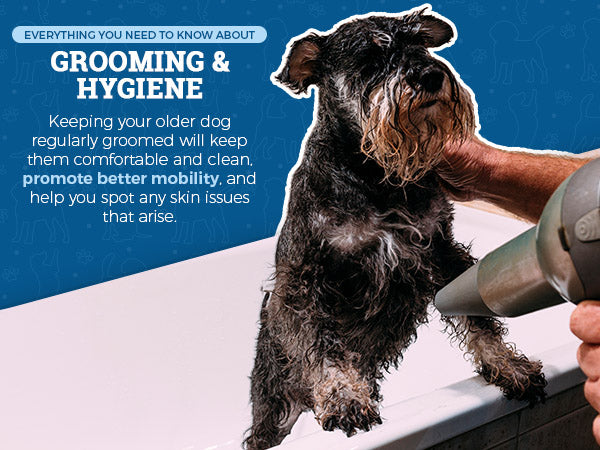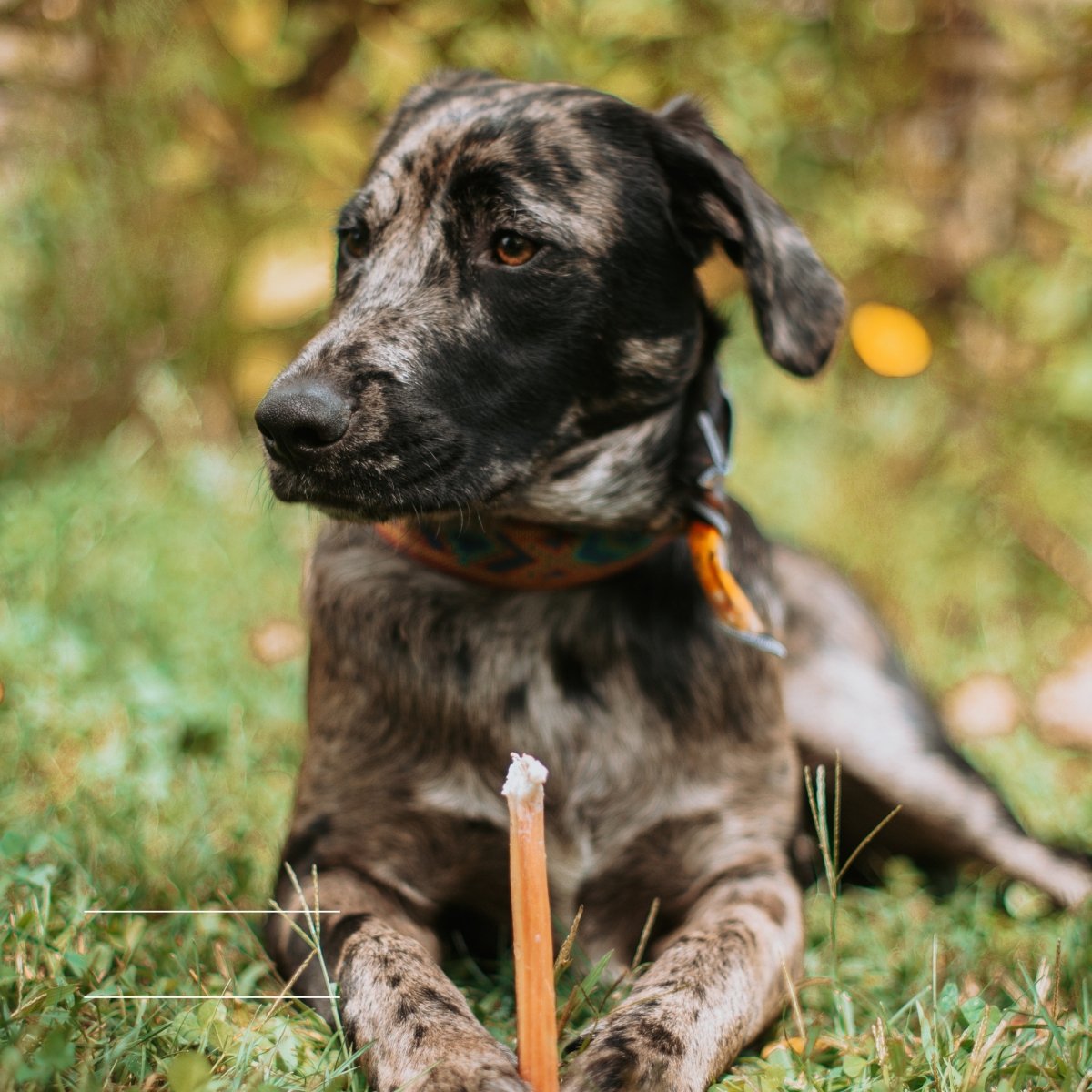

Getting old is hard on all of us, and it’s no different for your aging dog. You may have noticed your dog, who once seemed to have endless amounts of energy, is now slowing down and dealing with the effects of old age. In this ultimate guide, we’re going to break down senior dog care into five essential categories: diet and nutrition, mobility, grooming and hygiene, physical health conditions, and behavior and lifestyle.
As your dog ages, they will slow down, and being less active means that they burn fewer calories. If you keep feeding them the same amount of food that you always have, weight gain is very likely. While a few extra pounds might not seem like a big deal, it can exacerbate achy joints, mobility issues, and other age-related problems that your dog may develop.

Thus, you will likely need to cut back on the amount that you are feeding your dog in order to discourage this weight again. Calculate your dog’s average activity for each day and use that to calculate how many calories they should be eating. Then, convert it to the volume of food. Your vet can assist with this if you have trouble doing it on your own.
You might also want to talk to your vet about switching up your dog’s diet, including their dog food and dog bones. Senior dogs need a higher protein-to-calorie ratio in order to fight muscle mass loss and maintain their energy and metabolism. If their current food doesn’t provide enough protein in a smaller portion, you may need to switch to a different brand.
With that being said, you need to be careful with dog food that is marketed to senior dogs. The labeling of dog food is not heavily regulated, and companies often make claims on the label (not to mention marking up the price) in a way that isn’t necessarily reflected in the quality of the ingredients. Always read the label closely before purchasing a senior dog food to ensure that you are getting what you are paying for. You can always ask your vet for recommendations about which type of food to buy.
You might also need to supplement your dog’s diet with certain vitamins and minerals to ensure that they are getting all the nutrients they need to stay healthy and energetic. For instance, collagen chews for dogs will help promote a healthy coat and support mobility as they are.
Digestion issues are common in aging dogs, which may lead to older dogs vomiting after eating. While this could just be a normal occurrence of your dog’s stomach not agreeing with the food they ate, it can also be a sign of more serious digestion issues. To avoid this, give your dog easy-to-digest food and ensure they are eating at a slower pace.
If your dog does throw up after eating, hold off on giving them any more food, give them plenty of water to rehydrate, and consult your vet for the next steps. Your senior dog might even need to be put on a special diet of select human food, especially if the vomiting reoccurs. Think white rice, plain chicken, pureed pumpkin, etc. — foods that are packed with nutrients but easy to digest. Your vet will let you know if your dog needs this kind of food either temporarily or permanently.

Many dogs stay active and energetic well into their old age, so it’s important to keep exercising them as long as they are up for it in order to maintain their muscle mass and cardiovascular health. That notwithstanding, if your dog was previously extremely active (for instance, running obstacle courses or herding sheep), then you might need to transition them to a type of exercise that is a bit easier on their body. If you do notice your dog slowing down, you should still take them to the vet to get checked out. Their reduced activity could be a symptom of arthritis, untreated pain, or another health issue that needs to be addressed medically.
If your dog does have arthritis or another health condition that makes them unsteady on their feet, you might need to make some changes to your house to make it safer for them. Laying down rugs and carpet can help with traction and stability, while dog ramps can help them get up stairs or onto furniture. Wearing dog shoes with non-skid soles will give them a better grip whether they are walking inside or out. Raising their food and water bowls off the floor using a shelf or rack will reduce the strain on their neck while they eat or drink. If they have trouble standing or walking, a dog sling or mobility harness can give them the support they need to keep doing everyday activities.
As for aching joints, giving them gentle doggie massages can help relieve pain and swelling. If you have the extra finances, they may also benefit from visits to the chiropractor and the acupuncturist. If you’re on more of a budget, even placing hot towels fresh from the dryer on their joints can help soothe the achiness.
However, you do need to be careful with heat therapy, as aging dogs are less able to thermoregulate and may get too hot or too cold easily. Dogs who tend to run too cold will benefit the most from warming beds and other forms of heat therapy. If your dog tends to run hot, look for an orthopedic bed without a heating function to help them stay comfortable.

Keeping your older dog regularly groomed will keep them comfortable and clean, promote better mobility, and help you spot any skin issues that arise. Dogs may groom themselves less frequently as they age, which means that you will need to take up the slack with regular brushing and bathing sessions.
Be sure to trim your dog’s nails regularly to help with any discomfort while walking. Some dogs also have hair between their paw pads that can cause slipping when wet, so you should trim that hair short. A long coat may hide everything from a cancerous lump to a swaying spine, so you might wish to have the hair on the rest of their body trimmed short as well.
If you want to keep your dog’s coat long and fluffy, then consider having your vet create a body map. A body map is just a sketch or diagram that details the location and appearance of lumps and postural issues. A body map provides a baseline that you can consult to determine whether or not something has changed since the last routine check and can help you identify potentially cancerous lumps.
You may notice your older dog shedding excessively as they age. While some senior dogs may develop alopecia as a normal part of their aging process, excessive hair loss may also be a sign of illness, a hormonal abnormality, or nutritional deficiencies. If your dog starts losing a lot more hair than usual, take them to the vet for an examination to determine if it’s alopecia or something more serious.

Much like humans, dogs can develop health conditions at any age, but it is much more likely as they get older. Some of the most common health problems in senior dogs are dental diseases, arthritis, diabetes, kidney disease, and heart disease.
Due to this increased risk, your dog will need to step up their annual vet check-ins to twice a year instead of once a year. They might also need more vaccinations, additional parasite control, and other supplementary health care that they did not need when they were younger. Most vets will also want to run regular blood tests to make sure that their kidney and liver function is still within the normal range.
Older dogs are especially prone to issues with their hearing, vision, and mouth and teeth. Hearing loss can be caused by a temporary (and treatable) ear infection and discharge, or it may be more permanent if the hairs inside the ear have become damaged. Dogs may also develop cataracts as they age, just like people, or they may manifest another condition called progressive retinal atrophy (PRA). Your dog might also begin to struggle with loose teeth, infected gums, and other dental issues, making daily brushing and regular bully sticks for dogs a must.
Of course, if your dog is experiencing any issues with their health, you should consult your vet and develop a care plan based on your dog’s specific needs. Even if your dog has not been diagnosed with any health conditions yet, it is still important to keep an eye out and remain attentive as they age so you can catch early signs of any health condition that may arise. In particular, you should know the health conditions that are common for their breed, as well as their family history of health problems (if you have their breeding records).
Sign Up: Dog Treat Subscription Box

Due to a combination of all these factors, your once jovial and high-energy dog may be experiencing some major changes in their behavior. Many dogs will experience irregular sleep patterns, disorientation, lack of enthusiasm, and other unusual behaviors as they get older.
For instance, senior dogs generally require more sleep because of their decreased energy levels. If your dog seems to be sleeping more than usual, it is likely because they are exerting more energy doing everyday activities and need to recharge. Try not to interfere with your dog while they are sleeping and let them get the rest they need.
Disorientation is one of the most common symptoms in aging dogs. Your dog may look anxious or uncomfortable even when they are in their normal environment. They may start to forget their normal walk route or simple commands you have taught them. If this happens, schedule a checkup with your vet. While it is likely just a sign of aging, it’s important to rule out any other underlying health conditions, including canine cognitive dysfunction (CCD) — essentially the dog version of dementia. If your dog is diagnosed with CCD, you might need to make some lifestyle changes to slow its progression.
It can be hard to watch your companion grow old, but following these simple senior dog care tips will help your dog live their life as comfortably as possible. Always keep an eye out for changes in your dog’s behavior and consult your vet if something seems unusual. Remember to cherish the time spent with your dog and continue to make lifelong memories!
If you’d like to seize the day and treat your dog, then consider browsing our selection of healthy treats for senior dogs or signing up for our dog treat subscription box so you never have to worry about running out. Bully sticks are a great way to treat your dog and clean their teeth while mentally stimulating them. Try our bully sticks today, and you will notice the difference in quality!
Comments will be approved before showing up.

Check out our guide on different types of chews to help you decide on the best chew for your dog!

Let's take a closer look at why bully sticks are such a great choice for your dog!

Keeping your dog occupied isn’t just about preventing unwanted behaviors; it’s also vital for their overall health and happiness. Long-lasting chews offer an ideal way to provide the stimulation they need.